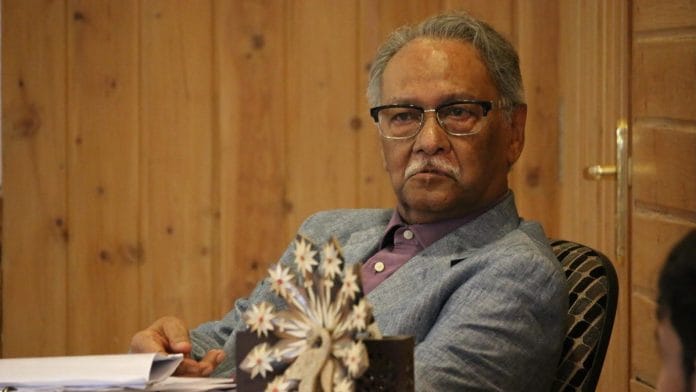New Delhi: During rehearsals of the plays, Raj Bisaria often disappeared. He wouldn’t sit in front of his actors, watching their every move. Instead, he would retreat to another room, listening—just listening. He would absorb the rhythm of the performance, catching hesitation, misplaced pause, unspoken nuance.
“If a scene didn’t sound right, it would never look right,” said Surya Mohan Kulshreshtha, actor, writer, and former student of Bisaria.
Rejected by the film industry for being too dark, too thin, and too educated, Bisaria found his true calling in theatre. Encouraged by Raj Kapoor and Prithviraj Kapoor, he turned to direction, training, shaping generations of actors. While many saw theatre as a stepping stone to films, he viewed it as a discipline, not a shortcut to fame.
“Theatre was the air he breathed, the language he spoke, and the fire that fueled him until his final years. Even past midnight, he would call me—deep in discussion about a character’s nuance, a scene’s rhythm, or a moment that needed sharpening,” Surya Mohan Kulshreshtha, former director of Bharatendu Natya Academy, told ThePrint.
For Bisaria, drama was both an art form and a discipline, something to be studied, dissected, and mastered with the same rigour as any academic pursuit.
Raj Bisaria was more than a director or teacher—he was an institution. A Padma Shri awardee, often hailed as the ‘father of modern theatre in North India’, he redefined Indian theatre by blending Eastern and Western artistic traditions. He founded the Theatre Arts Workshop in 1966 and the Bharatendu Natya Academy nine years later, shaping generations of artists.
Trained in London, Bisaria drew from Konstantin Stanislavski and Bertolt Brecht to develop his acting system. He transformed theatre into an intellectual and aesthetic pursuit. He died on 16 February, leaving behind a legacy that continues to inspire. His productions introduced modern, experimental theatre to Indian audiences, challenging conventions.
Defiant stages
In 1976, as the shadow of the Emergency loomed over India, dissent was dangerous, and silence was often the safest choice. Yet, in the heart of Lucknow, Bisaria made a choice that defied fear. He staged Ek Aur Dronacharya, a searing critique of the education system, university politics, and student exploitation. Inspired by the Mahabharata, the play drew unsettling parallels between Ekalavya’s forced sacrifice and the injustices of modern academia. At a time when questioning authority came with grave risks, Bisaria turned his stage into a battleground for truth.
Many urged him to reconsider. Friends warned him of the consequences. But he was unwavering. Refusing the security of an enclosed theatre, he directed the production in the open at Lucknow’s Begum Hazrat Mahal Park, making it a performance that belonged to the people.
“He was accused of being a communist,” Kulshreshtha said. “But those who truly knew him understood his deep spirituality and his logical approach to ideas. He was never interested in party politics—only in progressive thought.”
Bisaria’s theatre was never about spectacle alone—it was about provocation. He gave his actors the illusion of creative freedom while subtly guiding them toward his vision. “Every detail—lighting, music, costumes, even the rhythm of breath on stage—was curated with meticulous precision,” said Kulshreshtha. He demanded surrender to the art, not just from his performers but from himself too.
Bisaria, with his audacious storytelling and fearless intellect, was more than a pioneer—he was a movement.
“I may not have been able to do things the way I wanted to do, but I have not done the things I didn’t want to do,” he said in an interview with Hindustan Times.
Also read: Malayali artist A Ramachandran saw poverty for the first time in Kolkata. It changed his art
The dream, the disillusionment
Raj Bisaria was not just a theatre director; he was an institution-builder. The Bharatinath Academy, later Bharatendu Natya Academy (BNA), founded in 1975 in Lucknow, was his baby. When classes were held in the vacant halls and lobbies of Rabindra Bhavan, he fought to turn it into a full-fledged training ground for serious theatre practitioners.
“He never liked the statement that Bharatendu Academy should follow NSD’s (National School of Design) pattern,” Kulshreshtha said. “He used to say, ‘I am offering a complete course here; the training here is comprehensive. If a student, after studying here, still goes to NSD, I do not consider them my student. It means that something was lacking in my teaching.’”
Bisaria’s vision was clear: BNA was not meant to be a stepping stone to another institution—it was meant to stand as an equal.
But vision alone cannot sustain an institution.
Over time, politics and personal rivalries chipped away at what Bisaria had built. His relentless pursuit of autonomy often put him at odds with the system, and as the years went by, the resistance only grew stronger. Bureaucratic constraints weighed heavily on him—he had envisioned BNA as a truly independent institution, free from the grip of official interference.
“He resigned two or three times—not just from the directorship but from his association with BNA itself. Eventually, he resigned permanently,” said Kulshreshtha. “The void he left behind had already begun to take shape during his lifetime.”
When Kulshreshtha later became BNA’s director, he tried to persuade Bisaria to return.
“I personally requested him to take classes again, to work with students. But he refused to attend plays or events at BNA. He would say, ‘If the play is staged anywhere else, I will come, but I will not go to Bharatendu Natya Academy.’”
But Bisaria never lost his core philosophy. He remained a thinker, a challenger, a man unwilling to blindly follow conventions.
“He believed in questioning everything. He used to say that real freedom is when one has the right to ask questions,” said Kulshreshtha.
(Edited by Aamaan Alam Khan)






